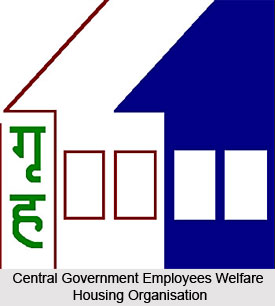 Central Government Employees Welfare Housing Organisation (CGEWHO) is an autonomous body functioning under the Union Government of India. It has been established to promote, control and co-ordinate the development of houses at selected places, across India, on no profit-no loss basis as a welfare measure. CGEWHO is a registered body under the Societies Registration Act 1860. It operates from its headquarters at Janpath Bhavan in New Delhi. There are no regional offices. The organisation maintains skeleton project teams at construction sites which look after day to day operations of construction and development.
Central Government Employees Welfare Housing Organisation (CGEWHO) is an autonomous body functioning under the Union Government of India. It has been established to promote, control and co-ordinate the development of houses at selected places, across India, on no profit-no loss basis as a welfare measure. CGEWHO is a registered body under the Societies Registration Act 1860. It operates from its headquarters at Janpath Bhavan in New Delhi. There are no regional offices. The organisation maintains skeleton project teams at construction sites which look after day to day operations of construction and development.
The goal of the organisation is to provide quality welfare service to Central Government Employees for housing. The organisation has the mandate to undertake social welfare schemes on no profit-no loss basis for Central Government Employees, both serving and retired, and spouses of deceased Central Government Employees by inter-alia promoting the construction of houses and providing all possible help and required inputs to achieve this object.
Organisation of CGEWHO
The organization functions under the aegis of then Ministry of Urban Development and Poverty Alleviation, Government of India. There are four levels of control in the organisation: General Body; Governing Council; Executive Committee and Chief Executive Officer. The General Body is a constitutional authority which lays down general policy guidelines and makes or amends Rules and Regulations of the society. Governing Council manages and administers the affairs of the society, approves requirements of staff and lays down policy for investment. Executive Committee looks after the day to day affairs of the organisation. Some of the powers of these bodies have been delegated to the Chief Executive Officer (CEO) who conducts the business and executes all contracts on behalf of the organisation. The organisation comprises three directorates, viz., Technical, Administration & Marketing and Finance, all supported by an IT cell.
Functions and Activities of CGEWHO
Acquisition of Land
The basis on which land is procured in a particular station and the quantum thereof is dependent upon concentration of the Central Government Employees or the demand pattern for that particular station. In order to make an objective assessment, specific demand surveys are conducted. Such demand surveys are also helpful in determining the ratio of various types of dwelling units (DUs) to be built in a project.
Planning of Projects
 Planning of projects is taken up only after firm allotment of the land has been obtained and the housing scheme is announced, subsequently. Procurement of land is made from the State Land Allotting Agencies or private agencies as considered appropriate, on case to case basis.
Planning of projects is taken up only after firm allotment of the land has been obtained and the housing scheme is announced, subsequently. Procurement of land is made from the State Land Allotting Agencies or private agencies as considered appropriate, on case to case basis.
Housing Scheme
A housing project, when planned and duly costed for different type of dwelling units, is offered to the eligible Central Government Employees as a `Housing Scheme`. The housing scheme so formulated is announced through newspapers, inviting applications from the interested and eligible Central Government Employees. For better dissemination of information regarding the housing schemes, other methods of communication used are CGEWHO`s newsletter, letters addressed to various offices of Central Government in India as well as abroad, etc. Then follows the process of registration and allotment. Applications are invited in pre-defined format (which is made available at a nominal cost on demand alongwith a brochure containing terms and conditions, known as `CGEWHO Rules`. A computerised draw, from amongst the eligible applicants, is held in case the number of applications received exceeds the number of dwelling units being offered. A small waiting list is also created, and further allotments are made based on withdrawals / cancellations. Allotment letters, issued to the successful applicants, include terms and conditions of allotment and tentative payment schedule. Instalments are called based on this payment schedule and progress of the project on ground.
Execution of Projects
Selection of a proper construction agency and the management and control of projects are the most important functions at this stage.
Closure
On receipt of the final payment from the beneficiaries, which includes the escalation and interest components, if any, the Apartment Owners Association charges etc., possession of the dwelling units is handed over to the beneficiaries. A CGEWHO project is expected to be handed over completely within five months of the date of issue of the final call-up letters. An effort is made to adhere to this schedule, including complying with statutory requirements like registration of the respective sale/lease deed etc. On completion of this activity, a project/scheme of the CGEWHO is considered as closed.




















